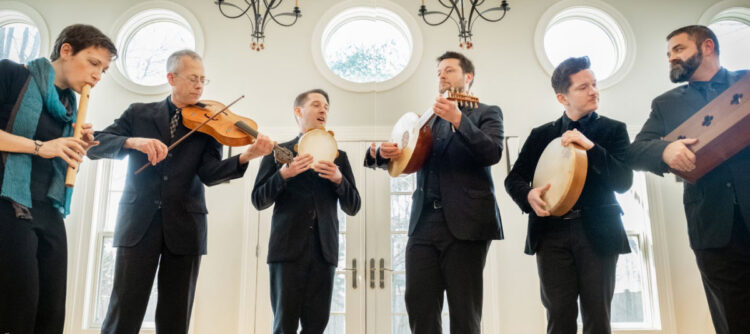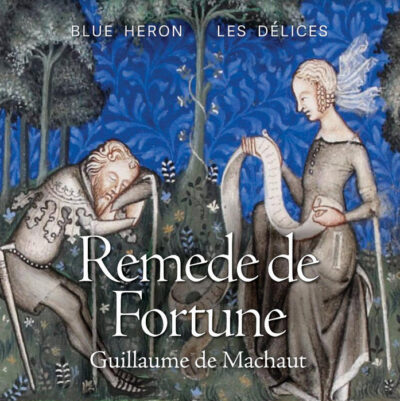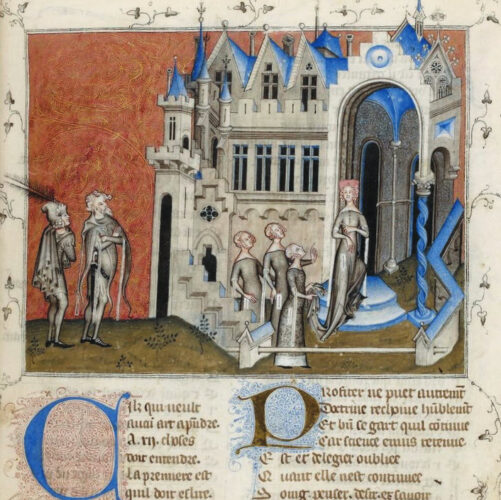by Jacob Jahiel
Published November 21, 2022
Guillaume de Machaut: Remede de Fortune Blue Heron and Les Délices. BHCD 1012

From Cicero to Shakespeare to the television game show Wheel of Fortune, the figure of Lady Fortuna—the ancient Roman goddess of luck and chance—has been an enduring literary and cultural symbol for over two millennia. In Guillaume de Machaut’s (1300-1377) long-form narrative poem, Le remède de fortune (The Remedy for Fortune), the Lady personifies capricious love, a force which, like luck, subjects those in its orbit to the mercy of unseen forces.

Machaut’s dit, including its seven lyric poems set to music, is now a collaborative project between two of America’s leading historically informed ensembles, Blue Heron and Les Délices. The partnership has resulted in a captivating new album, Remede de Fortune, released on the Blue Heron label.
Creating an album out of Machaut’s poem is not a straightforward task. A full performance, if such a thing ever existed, would have amounted to a medieval multimedia project entailing hours of music and narration as well as the perusal of its vividly illuminated manuscript, held at the Bibliothèque nationale de France. In a modern recording, the narration alone would test the mettle of even the most ardent medievalist, amounting to roughly 4,300 octosyllabic lines.
The ensembles’ artistic directors, Blue Heron’s Scott Metcalfe and Les Délices’ Debra Nagy, are not content to merely amputate the poem’s extra-musical elements. Instead, they draw from outside songs and motets that more concisely capture the narration’s themes. (In his thorough liner notes, Metcalfe jokes that “the Broadway production might be entitled Remede! The Musical.”)
The result is an album that is both musically compelling and narratively cohesive. Those with access to the text (which are included in the liner notes) will find Machaut’s didactic tale intact, recounting Lady Hope’s council to safeguard against the inconstant Lady Fortune, as well as the subsequent tale of love at first unrequited, later returned, and then again thrust into a state of uncertainty.
Not least, the album is musically satisfying. Listeners are thrust into the lovestruck inner world of trouvère-inspired love songs, while polyphonic motets and instrumental tracks serve to freshen the aural palate with added variety and thematic ballast.
Metcalfe (fiddle, harp) and Nagy (recorder, doućaine, harp) are joined by Owen McIntosh (tenor, drum), Jason McStoots (tenor), Martin Near (countertenor, tambourine), and Charles Weaver (baritone, lute, hurdy-gurdy). Each vocalist not only demonstrates a strong sense of musicality, but also the rhetorical prowess of a skilled orator, a necessary quality for a repertory with a less explicit text-to-music relationship than in later musical eras.

Meanwhile, instrumental accompaniment illuminates rather than obstructs the vocal lines, a respite from the sea of oversaturated recordings better suited for Game of Thrones than Guillaume de Machaut.
The lai, “Qui n’aroit autre deport,” exemplifies the conceptual creativity and adept delivery that characterizes the album. Even when excerpted to last around 11 minutes (the original is about 45!), the song’s length creates the risk of falling into monotony. As a solution, McStoots, Near, and McIntosh divvy up the strophes to represent three distinct points of view, and Metcalfe performs one strophe as an instrumental interlude. The result of careful attention to the mood of each word, line, and strophe contributes to a richly varied and vivid elucidation of the text.
Even in instrumental arrangements of songs, players seem to sing through their instruments. In the ballade, “Gais et joli,” Nagy and Weaver allow themselves to be guided by the unsung text, connecting long melismas over single words, mirroring vowels and consonances in their articulation, and organizing phrases like a singer.
While it is skill rather than fortune that has resulted in this rendition of Remede de Fortune, it is nonetheless a stroke of luck to receive an album so well-crafted and expertly performed.
Jacob Jahiel is a writer and violist da gamba residing in Montréal. He was a 2022 Rubin Institute for Music Criticism Fellow and is a recent graduate of the Jacobs School of Music at Indiana University, where he obtained an M.A. in musicology with an outside field in historical performance.




